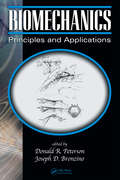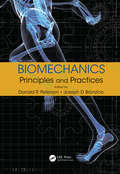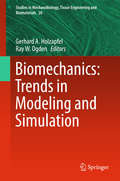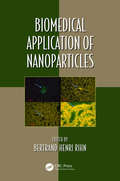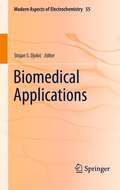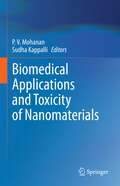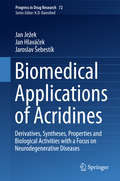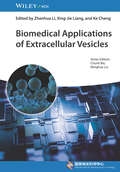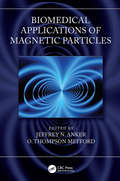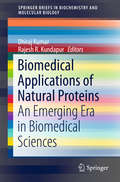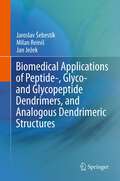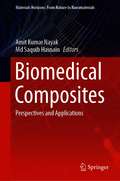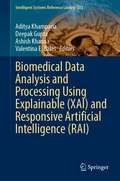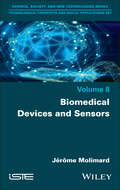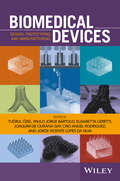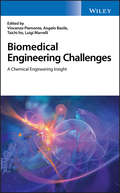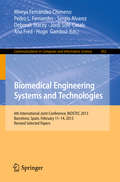- Table View
- List View
Biomechanics: Principles and Applications, Second Edition
by Joseph D. Bronzino Donald R. PetersonTraditionally, applications of biomechanics will model system-level aspects of the human body. As a result, the majority of technological progress to date appears in system-level device development. More recently, biomechanical initiatives are investigating biological sub-systems such as tissues, cells, and molecules. Fueled by advances in experime
Biomechanics: Principles and Practices
by Joseph D. Bronzino Donald R. PetersonThis book draws on material from the biomechanics section of The Biomedical Engineering Handbook, Fourth Edition, and includes additional chapters containing highly relevant, cutting-edge material dealing with cellular mechanics. Edited by Donald R. Peterson and Joseph D. Bronzino, it brings together contributions by world-class experts in the field. Offering an overview of major research topics in biomechanics, this is a useful resource for practitioners, scientists, and researchers in biomechanics, as well as biomedical engineering graduate students studying biomechanics, biodynamics, human performance engineering, and human factors.
Biomechanics: Trends in Modeling and Simulation (Studies in Mechanobiology, Tissue Engineering and Biomaterials #20)
by Ray W. Ogden Gerhard A. HolzapfelThe book presents a state-of-the-art overview of biomechanical and mechanobiological modeling and simulation of soft biological tissues. Seven well-known scientists working in that particular field discuss topics such as biomolecules, networks and cells as well as failure, multi-scale, agent-based, bio-chemo-mechanical and finite element models appropriate for computational analysis. Applications include arteries, the heart, vascular stents and valve implants as well as adipose, brain, collagenous and engineered tissues. The mechanics of the whole cell and sub-cellular components as well as the extracellular matrix structure and mechanotransduction are described. In particular, the formation and remodeling of stress fibers, cytoskeletal contractility, cell adhesion and the mechanical regulation of fibroblast migration in healing myocardial infarcts are discussed. The essential ingredients of continuum mechanics are provided. Constitutive models of fiber-reinforced materials with an emphasis on arterial walls and the myocardium are discussed and the important influence of residual stresses on material response emphasized. The mechanics and function of the heart, the brain and adipose tissues are discussed as well. Particular attention is focused on microstructural and multi-scale modeling, finite element implementation and simulation of cells and tissues.
Biomechatronics in Medical Rehabilitation: Biomodelling, Interface, And Control
by Shane S. Q. Xie Wei MengThis book focuses on the key technologies in developing biomechatronic systems for medical rehabilitation purposes. It includes a detailed analysis of biosignal processing, biomechanics modelling, neural and muscular interfaces, artificial actuators, robot-assisted training, clinical setup/implementation and rehabilitation robot control. Encompassing highly multidisciplinary themes in the engineering and medical fields, it presents researchers' insights into the emerging technologies and developments that are being utilized in biomechatronics for medical purposes. Presenting a detailed analysis of five key areas in rehabilitation robotics: (i) biosignal processing; (ii) biomechanics modelling; (iii) neural and muscular interfaces; (iv) artificial actuators and devices; and (v) the use of neurological and muscular interfaces in rehabilitation robots control, the book describes the design of biomechatronic systems, the methods and control systems used and the implementation and testing in order to show how they fulfil the needs of that specific area of rehabilitation. Providing a comprehensive overview of the background of biomechatronics and details of new advances in the field, it is especially useful for researchers, academics and graduates new to the field of biomechatronics engineering, and is also of interest to researchers and clinicians in the medical field who are not engineers.
Biomedical Application of Nanoparticles (Oxidative Stress and Disease)
by Bertrand RihnBiomedical Application of Nanoparticles explores nanoparticles, their chemical and physicals properties, and how they interact in biological systems with proteins, immune system and targeted cells. Risk assessment of nanoparticles for human is described, including: cellular paradigms, transcriptomics and toxicogenomics. Finally, the applications of nanoparticles in medicine and antioxidant regenerative therapeutics are presented in several chapters with emphasis on how nanoparticles enhance transport of drugs across biological membrane barriers and therefore may enhance drug bioavailability.
Biomedical Applications (Modern Aspects of Electrochemistry #55)
by Stojan S. DjokićVarious metallic or non-metallic surfaces are frequently treated by elewctrochemical methods (e.g. electrodeposition, electroless deposition, anodization, passivation, etc.) in order to achieve a desirable property important for biomedical applications. Applications include orthopedic or dental implants, dressings for wound healing and different skin diseases, surfaces for the prevention of bio-film formation of corrosion inhibition in biological media. The aim of this issue of Modern Aspects of Electrochemistry is to review the latest developments of the surface treatments for biomedical applications in relation to electrochemical science and technology. This new volume of Modern Aspect of Electrochemistry brings to the scientists, engineers and students summarized results and new concepts of surface treatments for the biomedical applications which may have significant influence for the future practical applications.
Biomedical Applications and Toxicity of Nanomaterials
by P. V. Mohanan Sudha KappalliThis book covers the recent trends on the biological applications of nanomaterials, methods for their preparation, and techniques for their characterization. Further, the book examines the fundamentals of nanotoxicity, methods to assess the toxicity of engineered nanomaterials, approaches to reduce toxicity during synthesis. It also provides an overview of the state of the art in the application of Artificial intelligence-based methodologies for evaluation of toxicity of drugs and nanoparticles. The book further discusses nanocarrier design, routes of various nanoparticle administration, nano based drug delivery systems, and the toxicity challenges associated with each drug delivery method. It presents the latest advances in the interaction of nanoparticles with the cellular environment and assess nanotoxicity of these engineered nanoparticles. The book also explores the comparative and mechanistic genotoxicity assessment of the nanomaterials. This book is useful source of information for industrial practitioners, policy makers, and other professionals in the fields of toxicology, medicine, pharmacology, food, and drugs.
Biomedical Applications of Acridines: Derivatives, Syntheses, Properties and Biological Activities with a Focus on Neurodegenerative Diseases (Progress in Drug Research #72)
by Jan Ježek Jan Hlaváček Jaroslav ŠebestíkThis book describes applications of acridines for the treatment of various neurodegenerative diseases, such as Alzheimer's disease, Parkinson's disease, and various prion diseases, and discusses the potential of acridines in neuro-regenerative medicine. Using modern data-mining software, it presents structures of acridines with nucleic acids and proteins and compares them with the native structures. Furthermore, the book presents modern methods of acridine synthesis, comparing them with the most useful conventional methods. Acridines interact with both nucleic acids and proteins, and due to their direct interactions with various enzymes, they can be suitable for the treatment of neurodegenerative diseases, inflammation, immunological disorders, and protozoal diseases. The characteristic spectral properties of acridines can be employed in labeling proteins, nucleic acids, lipids, and even cells and their compartments. Moreover, they can be applied in photodynamic therapy.
Biomedical Applications of Computer Modeling (Handbooks in Pharmacology and Toxicology)
by Arthur ChristopoulosUp to the last decade or so, most general modeling approaches to the study of molecular components of biological responses have required significant amount of computer time, expertise, and resources, as well as highly specialized and often custom-written programs. With Biomedical Applications of Computer Modeling you don't have to be a computer sci
Biomedical Applications of Extracellular Vesicles
by Zhenhua Li Xing-Jie Liang Ke ChengBiomedical Applications of Extracellular Vesicles Unique resource focusing on biomedical applications and clinical translation of extracellular vesicles in science and medicine Focusing on key points to better understand extracellular vesicles (EVs) and their development, Biomedical Applications of Extracellular Vesicles describes in detail the biogenesis of EVs, the mechanism of intercellular communication, and the treatment of various diseases of EVs and the EV-based drug delivery platforms. An application-oriented resource, the work presents rapidly newer biomedical and clinical applications of natural and engineered EVs such as drug delivery, diagnosis, prognosis monitoring, immunotherapy, and more. The first part of this book provides a basic background on EVs. Next, the book introduces the excellent therapeutic effects of EVs themselves and the underlying mechanisms, followed by how EVs from different sources were used to construct drug delivery platforms. The latest research on EVs from leading groups around the world is presented. Sample topics covered in Biomedical Applications of Extracellular Vesicles include: Biogenesis of various EVs Pros and cons of the different instrumental and methodological developments for analytical strategies applied to EVs EVs in treatment of major diseases, such as cancer, cardiovascular and respiratory diseases Current methods of engineering EVs, and a comparison of the advantages and disadvantages of each method Biomaterials, such as hydrogels, scaffolds, and microneedles, that have been developed to further enhance the therapeutic efficacy of EVs Key challenges, such as quality control, scalability, and biosafety, that limit the clinical and industrial translation of EVs Explaining in detail how extracellular vesicles are produced and engineered, along with potential applications and commercial developments of EVs in science and industry, Biomedical Applications of Extracellular Vesicles is an essential resource on the subject for chemists, cell biologists, and molecular physicists.
Biomedical Applications of Magnetic Particles
by Jeffrey N. Anker O. Thompson MeffordBiomedical Applications of Magnetic Particles discusses fundamental magnetic nanoparticle physics and chemistry and explores important biomedical applications and future challenges. The first section presents the fundamentals of the field by explaining the theory of magnetism, describing techniques to synthesize magnetic particles, detailing methods to characterize magnetic particles, and quantitatively describing the applied magnetic forces, torques, and the resultant particle motions. The second section describes the wide range of biomedical applications, including chemical sensors, cellular actuators, drug delivery, magnetic hyperthermia, magnetic resonance imaging contrast enhancement, and toxicity. Additional key features include: Covers both introduction to physics and characterization of magnetic nanoparticles and the state of the art in biomedical applications Authoritative reference for scientists and engineers for all new or old to the field Describes how the size of magnetic nanoparticles affects their magnetic properties, colloidal properties, and biological properties. Written by a team of internationally respected experts, this book provides an up-to-date authoritative reference for scientists and engineers.
Biomedical Applications of Mesoporous Ceramics: Drug Delivery, Smart Materials and Bone Tissue Engineering
by María Vallet-Regí Miguel Manzano García Montserrat ColillaDevelopments in mesoporous ceramics in drug delivery, nanomedicine, and bone tissue regeneration have opened promising developments in biomedical research, many applicable in the clinic in the near future. Due to the ability to fine-tune the physicochemical properties of these materials, the field has experienced an impressive burst in the number o
Biomedical Applications of Natural Proteins: An Emerging Era in Biomedical Sciences (SpringerBriefs in Biochemistry and Molecular Biology)
by Dhiraj Kumar Rajesh R. KundapurThis book is intended as a reference guide for graduate students, postgraduate students and researchers with a basic knowledge of protein chemistry who would like to know more about the biomedical applications of natural proteins to promote healthier lives. The book is divided into ten chapters, each of which explains different natural proteins and their established biomedical applications. The first chapter extensively deals with protein based natural fibers and provides an overview of all protein based fibers currently available. In turn, chapter two mainly focuses on the biomedical applications of a special class of proteins called Heat Shock Proteins; the biomedical applications of silkworm pupae proteins are dealt in chapter three. Chapter four examines an interesting use of Eri silk fibroin as a biomaterial for Tissue Engineering, while chapter five discusses the key experimental details involved in converting Tasar silk sericin into self-assembled nanoparticles. Chapter six offers brief descriptions of bioactive proteins with respect to their sources, synthesis and applications. Chapter seven is dedicated to Interleukine-8 and its role in human life, while chapter eight addresses the importance of natural proteins in infectious diseases. Chapter nine explores the issue of excess intake of dietary proteins and its adverse effects, and finally, chapter ten discusses the efficiency of drug delivery systems made up of gelatin nanocomposites. The book is above all intended as a valuable resource for students and researchers alike, sparking their curiosity with regard to the applications of natural proteins and motivating them to focus their own energies on the discovery or identification of additional natural proteins for diverse biomedical uses.
Biomedical Applications of Peptide-, Glyco- and Glycopeptide Dendrimers, and Analogous Dendrimeric Structures
by Jaroslav Sebestik Jan Jezek Milan ReinisDendrimers are repeatedly branched and roughly spherical large molecules. They can be used in various medical applications, such as anticancer polymeric nanomedicines and nanocarriers, gene carriers and vectors in gene delivery, contrast agents for molecular imaging and vaccines against infectious diseases and cancer. The highly branched, multivalent nature and molecular architecture of dendrimers make them ideal tools for a variety of tissue engineering applications. This book describes different categories of dendrimers, their biomedical and physico-chemical applications as well as convergent and divergent syntheses, click chemistry and ligation strategies. It is a rich source of information for researchers in biochemistry and pharmacology working on drug development as well as for organic chemists who are engaged in synthesis of dendrimers.
Biomedical Composites: Perspectives and Applications (Materials Horizons: From Nature to Nanomaterials)
by Amit Kumar Nayak Md Saquib HasnainThis book provides an overview of biocomposite chemistry, chemical modifications, characterization and applications in biomedicine, with emphasis on recent advances in the field. Authored by experts, the chapters discuss the design, development and selection of biomedical composites for a particular therapeutic application, as well as providing insight into the regulatory and clinical aspects of biomedical composite use. While this book is primarily intended for scientists from the fields of medical, pharmaceutical, biotechnological and biomedical engineering, it is also useful as an advanced text for students and research scholars.
Biomedical Data Analysis and Processing Using Explainable (Intelligent Systems Reference Library #222)
by Valentina E. Balas Deepak Gupta Ashish Khanna Aditya KhampariaThe book discusses Explainable (XAI) and Responsive Artificial Intelligence (RAI) for biomedical and healthcare applications. It will discuss the advantages in dealing with big and complex data by using explainable AI concepts in the field of biomedical sciences. The book explains both positive as well as negative findings obtained by explainable AI techniques. It features real time experiences by physicians and medical staff for applied deep learning based solutions. The book will be extremely useful for researchers and practitioners in advancing their studies.
Biomedical Devices and Sensors
by Jérôme MolimardMonitoring the human body is a key element of digital health science. Low-cost sensors derived from smartphones or smartwatches may give the impression that sensors are readily available; however, to date, very few of them are actually medical devices. Designing medical devices requires us to undertake a specific approach demanding special skills, as it concerns the integrity of the human body. The process is tightly framed by state regulations in order to ensure compliance with quality assessment, risk management and medical ethics requirements. This book aims to give biomedical students an overview on medical devices design. It firstly gives a historical and economical approach, then develops key elements in medical device design with reference to EU and US regulations, and finally describes sensors for the human body. The clinical approach is presented as the central element in medical device qualification and this offers a perspective on the use of numerical simulation, particularly since its continued growth in the USA; despite the fact that the approach is strictly limited by regulations.
Biomedical Devices: Design, Prototyping, and Manufacturing
by Paolo Jorge Bártolo Elisabetta Ceretti Jorge Vicente Da Silva Tŭgrul Özel Ciro Angel Rodriguez Joaquim De GayBiomedical Devices: Design, Prototyping, and Manufacturing features fundamental discussions of all facets of materials processing and manufacturing processes across a wide range of medical devices and artificial tissues. Represents the first compilation of information on the design, prototyping, and manufacture of medical devices into one volume Offers in-depth coverage of medical devices, beginning with an introductory overview through to the design, manufacture, and applications Features examples of a variety of medical applications of devices, including biopsy micro forceps, micro-needle arrays, wrist implants, spinal spacers, and fixtures Provides students, doctors, scientists, and technicians interested in the development and applications of medical devices the ideal reference source
Biomedical Electronics, Noise Shaping ADCs, and Frequency References: Advances in Analog Circuit Design 2022
by Kofi A. A. Makinwa Andrea Baschirotto Pieter HarpeThis book is based on the 18 tutorials presented during the 30th workshop on Advances in Analog Circuit Design. Expert designers present readers with information about a variety of topics at the frontier of analog circuit design, with specific contributions focusing on analog circuits for machine learning, current/voltage/temperature sensors, and high-speed communication via wireless, wireline, or optical links. This book serves as a valuable reference to the state-of-the-art, for anyone involved in analog circuit research and development.
Biomedical Engineering Challenges: A Chemical Engineering Insight
by Luigi Marrelli Angelo Basile Vincenzo Piemonte Taichi ItoAn important resource that puts the focus on the chemical engineering aspects of biomedical engineering In the past 50 years remarkable achievements have been advanced in the fields of biomedical and chemical engineering. With contributions from leading chemical engineers, Biomedical Engineering Challenges reviews the recent research and discovery that sits at the interface of engineering and biology. The authors explore the principles and practices that are applied to the ever-expanding array of such new areas as gene-therapy delivery, biosensor design, and the development of improved therapeutic compounds, imaging agents, and drug delivery vehicles. Filled with illustrative case studies, this important resource examines such important work as methods of growing human cells and tissues outside the body in order to repair or replace damaged tissues. In addition, the text covers a range of topics including the challenges faced with developing artificial lungs, kidneys, and livers; advances in 3D cell culture systems; and chemical reaction methodologies for biomedical imagining analysis. This vital resource: Covers interdisciplinary research at the interface between chemical engineering, biology, and chemistry Provides a series of valuable case studies describing current themes in biomedical engineering Explores chemical engineering principles such as mass transfer, bioreactor technologies as applied to problems such as cell culture, tissue engineering, and biomedical imaging Written from the point of view of chemical engineers, this authoritative guide offers a broad-ranging but concise overview of research at the interface of chemical engineering and biology.
Biomedical Engineering Fundamentals (The Biomedical Engineering Handbook, Fourth Edition)
by Joseph D. Bronzino Donald R. PetersonKnown as the bible of biomedical engineering, The Biomedical Engineering Handbook, Fourth Edition, sets the standard against which all other references of this nature are measured. As such, it has served as a major resource for both skilled professionals and novices to biomedical engineering.Biomedical Engineering Fundamentals, the first volume of
Biomedical Engineering Principles
by Arthur B. Ritter Vikki Hazelwood Antonio Valdevit Alfred N. AscioneCurrent demand in biomedical sciences emphasizes the understanding of basic mechanisms and problem solving rather than rigid empiricism and factual recall. Knowledge of the basic laws of mass and momentum transport as well as model development and validation, biomedical signal processing, biomechanics, and capstone design have indispensable roles i
Biomedical Engineering Systems and Technologies: 6th International Joint Conference, BIOSTEC 2013, Barcelona, Spain, February 11-14, 2013, Revised Selected Papers (Communications in Computer and Information Science #452)
by Jordi Solé-Casals Ana Fred Mireya Fernández-Chimeno Pedro L. Fernandes Sergio Alvarez Deborah Stacey Hugo GamboaThis book constitutes the thoroughly refereed post-conference proceedings of the 6th International Joint Conference on Biomedical Engineering Systems and Technologies, BIOSTEC 2013, held in Barcelona, Spain, in February 2013. The 28 revised full papers presented were carefully reviewed and selected from a total of 392 submissions. The papers cover a wide range of topics and are organized in four general topical sections on biomedical electronics and devices; bioinformatics models, methods and algorithms; bio-inspired systems and signal processing; health informatics.
Biomedical Engineering Systems and Technologies: 7th International Joint Conference, BIOSTEC 2014, Angers, France, March 3-6, 2014, Revised Selected Papers (Communications in Computer and Information Science #511)
by Ana Fred Hugo Gamboa Guy Plantier Tanja SchultzThis book constitutes the thoroughly refereed post-conference proceedings of the 7th International Joint Conference on Biomedical Engineering Systems and Technologies, BIOSTEC 2014, held in Angers, France, in March 2014. The 25 revised full papers presented were carefully reviewed and selected from a total of 362 submissions. The papers cover a wide range of topics and are organized in topical sections on biomedical electronics and devices; bioimaging; bioinformatics models, methods and algorithms; bio-inspired systems and signal processing; health informatics.
Biomedical Engineering Systems and Technologies: 8th International Joint Conference, BIOSTEC 2015, Lisbon, Portugal, January 12-15, 2015, Revised Selected Papers (Communications in Computer and Information Science #574)
by Ana Fred Hugo Gamboa Dirk EliasThis book constitutes the thoroughly refereedpost-conference proceedings of the 8th International Joint Conference onBiomedical Engineering Systems and Technologies, BIOSTEC 2015, held in Lisbon,Portugal, in January 2015. The 27 revised full papers presented together with aninvited paper were carefully reviewed and selected from a total of 375submissions. The papers cover a wide range of topics and are organized in fourgeneral topical sections on biomedical electronics and devices;bioimaging; bioinformatics models,methods and algorithms; bio-inspired systems and signalprocessing; health informatics.
